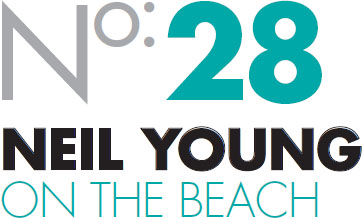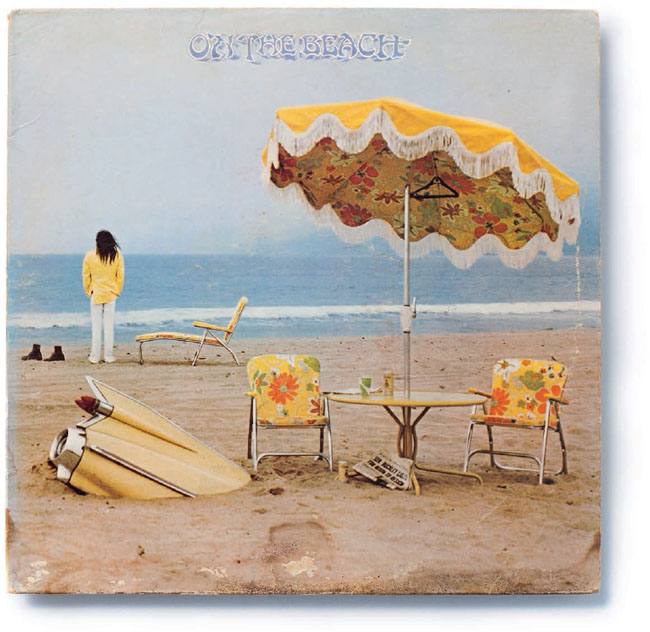
Reprise
Produced by Neil Young, David Briggs and Mark Harman
Released: July 1974
TRACKLISTING
01 Walk On
02 See the Sky About to Rain
03 Revolution Blues
04 For the Turnstiles
05 Vampire Blues
06 On the Beach
07 Motion Pictures
08 Ambulance Blues
On the Beach is the title of a Gregory Peck film about the few people left alive in Melbourne, Australia after nuclear war has destroyed the northern hemisphere. In the film they get a signal from San Diego suggesting that someone in California survived Armageddon. On the cover of the album On the Beach, Neil Young stands beside his boots in front of a Cadillac buried in the sand. He is staring out at the Pacific. He could just be that survivor.
In 1972 Harvest made Neil Young a superstar. ‘Harvest was probably the finest record that I’ve made,’ he said. ‘But that’s really a restricting adjective for me.’ He reacted, saying he left the mainstream and ‘headed for the ditch’. Young made three albums – Time Fades Away, On the Beach and Tonight’s the Night, which are commonly referred to as ‘the ditch trilogy’ because they were mostly bleak albums that were recorded roughly, almost haphazardly, and the songs were the antithesis of his monster Harvest hits ‘Heart of Gold’ and ‘Old Man’.
On the Beach was not enthusiastically received on its release in 1974. The drugs then circulating in Young’s world – heroin and cocaine – were taking their toll. The Watergate scandal was ripping apart the American dream. The fans wanted escape or consolation, not a downer.

The album opens happily enough with the jaunty track ‘Walk On’, a reply to Lynyrd Skynyrd’s ‘Sweet Home Alabama’, which itself was a reply to Young’s ‘Southern Man’. ‘Walk On’ is also a statement of Young’s credo – to keep moving. ‘See the Sky About to Rain’ is a country lament that predates Harvest, but its mood of impending doom fits better here. ‘Revolution Blues’ is a song about the Sharon Tate killings sung from Charles Manson’s point of view. ‘I knew Charlie Manson,’ Young told the Guardian. ‘I was meeting them and he was not a happy guy … It was the ugly side of the Maharishi. You know, there’s one side of the light, nice flowers and white robes and everything, and then there’s something that looks a lot like it but just isn’t it at all.’ ‘Revolution Blues’ features one of Young’s best, most colourful verses, both witty and spine chilling: ‘I got the revolution blues/I see bloody fountains/And ten million dune buggies/Comin’ down the mountains/Well, I hear that Laurel Canyon/Is full of famous stars/But I hate them worse than lepers/And I’ll kill them/In their cars’. Crosby, Stills and Nash didn’t see the humour and refused to perform the song on the CSN&Y tour in ’74.
The title cut moves at an almost somnolent pace lit by flashes of light from Young’s guitar. It’s a song about feeling hollow, going through the motions of the music business and the incessant progress of time ending with Young’s usual solution: ‘I head for the sticks/With my bus and friends/I follow the road/Though I don’t know/Where it ends’.
The melody of ‘Ambulance Blues’ comes from Bert Jansch’s ‘Do You Hear Me Now?’. The story begins in the Riverboat folk club, where Young started out. From there he meanders past the hippies burned out on their dreams, superstars going through the motions in arenas. John Paul Getty Jr’s kidnapping by Italian revolutionaries cutting off his ear is covered in ‘the entertainment section’ – a remarkably prescient observation considering the way that news has now converged with pop culture. Finally there’s the image of Nixon (‘I never knew a man/Could tell so many lies’) who would appear in many of Young’s best songs. The song returns to Toronto with Young playing with Crosby, Stills, Nash and Young, suggesting his old friends are ‘pissin’ in the wind’.
‘Everybody said that Harvest was a trip,’ Young said in 1974. ‘But that was only me for a couple of months. I’m just not that way anymore.’